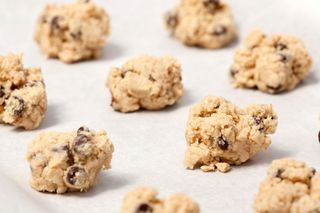Cookie Dough E. Coli Outbreak Still Has Mysterious Origins

Exactly how cookie dough came to be contaminated with E. coli bacteria, sickening 77 people in 30 states in June 2009, remains unclear, according to a new analysis of that outbreak.
One thing that is clear, though, is that consumers should not eat any unbaked cookie dough, researchers said.
It seems most likely that one of the ingredients used to make the cookie dough was contaminated, and the flour remains "the prime suspect," according to the report from researchers at the Centers for Disease Control and Prevention (CDC) and state health departments.
Still, there was no conclusive evidence that tainted flour was responsible, according to the report.
There were no deaths linked to the outbreak, which was the first in which "Shiga toxin-producing" E. coli O157 was linked to ready-to-bake cookie dough, according to the report.
Most of those sickened were women and girls, according to the report.
The outbreak led to the recall of 3.6 million packages of Nestle Toll House cookie dough, according to the Food and Drug Administration.
Sign up for the Live Science daily newsletter now
Get the world’s most fascinating discoveries delivered straight to your inbox.
The report was published online today (Dec. 9) in the journal Clinical Infectious Diseases.
E. coli and food
Since the mid-1980s, E. coli O157 has been linked to more than 180 reports of foodborne illness outbreaks in the U.S., according to the report. Ground beef, leafy green vegetables and unpasteurized dairy products are common sources.
The bacteria cause gastrointestinal illness that can be severe, especially in young children and the elderly, and 4 percent to 13 percent of patients can be struck with hemolytic-uremic syndrome, in which injury to the kidneys can lead to lifelong need for dialysis treatments.
The researchers concluded that the most likely source of the 2009 outbreak was a contaminated ingredient, and flour was the most likely culprit, according to the report. Unlike other ingredients such as sugar and baking soda, flour is not processed in a way that would kill bacteria.
The use of large quantities of flour in the manufacturing of multiple lots and varieties of dough was consistent with the pattern of contaminated products, the report said.
However, when the researchers inspected the plant and tested the flour by growing bacterial cultures from samples of it, they found no E. coli O157, nor did they find the bacteria in the mill where the flour was produced.
Although eggs were used to make the dough, the eggs were pasteurized and so were unlikely to have brought in the bacteria.
Chocolate chips were also considered a possible source — most of the sick patients reported eating dough of chocolate chip cookies, and a previous study demonstrated E. coli can survive in chocolate for over a year. However, the chips used in the cookies were also use in other products, and no other products were linked to sick people, so the researchers concluded they were unlikely to be the source of theE. coli.
The researchers said they found no food handling or safety violations that that could have resulted in cross-contamination within the plant, nor did they find "any obvious breach in biosecurity," that would have lead to pathogens from outside the facility making their way into the food, according to the report.
And the researchers found no evidence that the contamination was intentional, according to the report.
Protecting against future outbreaks
The researchers said consumers should be reminded not to eat uncooked dough.
The report said more effective consumer education about the risks of consuming unbaked goods is needed, pointing out that some patients sickened in the 2009 outbreak said in interviews that they bought the dough with the intention of eating it unbaked. Further, a study showing that 53 percent of college students reported consuming unbaked homemade cookie dough.
The practice of eating unbaked dough seems particularly popular among adolescent girls, the report noted.
They also recommended that cookie dough manufacturers consider reformulating their products to make them safe as ready-to-eat products.
Pass it on: Don't eat raw cookie dough.
Follow MyHealthNewsDaily on Twitter @MyHealth_MHND. Find us on Facebook.
Most Popular


